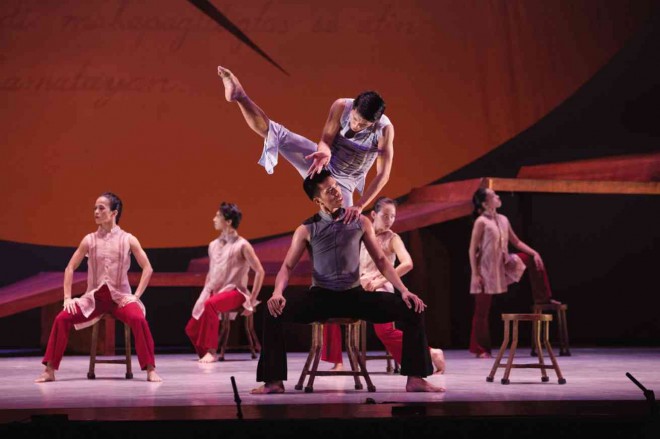
An Agnes Locsin piece is all about ensemble.
It is a moving tapestry of various emotions occurring at the same time, painting a full picture, according to the choreographer’s vision, of the narrative all at once, forcing the spectator to pan his eyes from stage right to left so as not to miss a single nuance.
What better way to use this Locsin forte than in an opus about a young nation’s high-pitched early revolution against foreign oppressors?
But unlike other theatrical Revolution pieces, Locsin’s shrillness is distilled in united, frenzied, disjointed and angular movements, all the more underscoring the spoken cry for independence by a nation, and the silent scream of a crippled hero pondering the wisdom of his choice to support an outright armed offense, as opposed to his prior stand of peaceful negotiation, or, in his term, evolution.
Locsin’s “La Revolucion Filipina,” titled after Apolinario Mabini’s memoir written while he was in exile in Guam, has been staged and restaged four times since its premiere in 1996. With every restaging, Locsin’s intent becomes clearer.
I am not too sure if it is due to her subtle tweaks, or to my own grown-up and mature perceptions since its premiere. But like all things that mellow or ripen with age, Locsin’s “La Rev,” this time has acquired its full-bodied flavor.
For one, Locsin’s eloquent dance vocabulary enables her to express on multilevels a single emotion, much like an operatic aria or a Shakesperean soliloquy, specifically in the nonspeaking part of Mabini.
Pas de deux with hammock
Using the genre of Tanz theater, the production gives leads lines to speak. But not the character of Mabini, supremely given life by guest artist Sonny Locsin. It helps that his well-oiled limbs exude the sentiments as a paralytic, and the brains behind the Katipunan.
Locsin the choreographer very smartly mutes him, giving him movements instead, which embody the mobility and energy of Mabini’s intelligence, not relegating him to the cliché limping of a paralytic.
Once that aspect of Mabini is established through a pas de deux with his rattan hammock, the choreographer thrusts head-on to put into movement Mabini’s ideologies.
Locsin the dancer does not disappoint. Just as his choreographer aunt has a vast dance vocabulary, so does he have an experienced mastery of his body, honed over the years from working with foreign dance companies and choreographers, such as Jeune Ballet de France, whose repertoire can sometimes be physically punishing; and the delightful Twyla Tharp, whose fluid and rubbery dance style is a witty take on the rigidity of classical ballet.
Although Locsin does not waste time explaining through words and anguished dance steps the political intricacies of the plot, she does not sacrifice the clarity of her narrative.
Inner conflicts
The plot is driven by the inner conflicts of the lead characters—Mabini, Aguinaldo and, to a lesser extent, Bonifacio (who is executed early on)—more than the outer physical conflicts and arguments among the three heroes.
This treatment affords Locsin more imaginative choreographic time which she milks fully.
Aside from a hero’s physique and a tempered dance technique, Richardson Yadao is also gifted with resonance of voice. The dialogue, which is mostly assigned to his character Emilio Aguinaldo, is adapted by librettist Dennis Marasigan from actual documents.
Because of the authenticity of the dialogue’s source, I can forgive the times when it sometimes comes off as a trifle didactic. But the dancing makes up for that.
Because Locsin’s dance language is all her own, developed over the years with her inspired takes on Philippine tribal movements, textured with classical ballet and modern-dance techniques, or maybe the other way around, she takes liberties at inventing and reinventing moves: stiff flexed feet with sweeping upper body twitches; tours en l’air with a kind of tribal hand movement.
Many of her works, whether she intends it or not, seem powered by testosterone.
But no one in the audience is complaining, especially when the heat comes on for a whole population dancing in unison to Ryan Cayabyab’s ethnic-flavored score.
Even the female dancers start to reek of warrior’s musk. In Locsin’s language, strong emphatic movements cross genders.
At the end of her Revolution, Locsin splays on her personal epilogue through the irony of her heroes’ realizations: Aguinaldo “paralyzed by his belief that he no longer holds any lofty position,” and Mabini “rising from his chair accusing the present of turning its back on the past.”
Where the Philippine Revolution failed, “La Revolucion Filipina” more than succeeds. It is truly destined to be a classic, if it is not yet one.